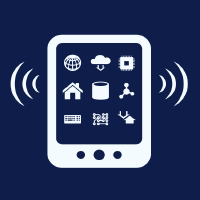Topic Menu
► Topic MenuTopic Editors
2. Department of Aerospace, California Institute of Technology, Pasadena, CA 91125, USA
Smartphone Positioning, Navigation and Timing: Advances and Challenges
Topic Information
Dear Colleagues,
As you are all aware, the capabilities of smartphones have greatly evolved over the past decade. With increased computing power and the accessibility to observations collected by various embedded systems, such as an integrated global navigation satellite system (GNSS) chipset, microelectromechanical system (MEMS) inertial sensors, magnetometers, barometers, and high-resolution cameras, smartphones are now a powerful platform for pedestrian and automotive navigation as well as for a wide variety of other applications such as mobile mapping, health monitoring, gaming, and more.
However, one of the major challenges of using smartphones for all these tasks and applications is the quality and availability of their sensors' measurements in various environments. In particular, in positioning applications, the errors affecting these measurements can significantly degrade the achievable performance in terms of accuracy, especially in scenarios where GNSS signals are impaired or unavailable, such as deep urban canyons or indoors. In addition, the flip side of the coin is that most of these devices are gathered in urban areas where GNSS is mostly susceptible to multipath interference and occlusions. This combination makes smartphones and mobile devices to a large extent a favorable breeding ground for innovative and disruptive solutions.
We look forward to receiving contributions that focus on the use of smartphones for positioning and all related applications using GNSS and/or other integrated sensors. We are particularly interested in original papers that address innovative techniques, methods, and algorithms for navigation using smartphones in GNSS-degraded or -denied scenarios, such as in the presence of urban canyons or in indoor environments.
Topics of interest include (but are not limited to):
- Pedestrian–automotive navigation and situational awareness in challenging environments (e.g., deep urban canyons and tunnels);
- Approaches, methods, and algorithms for positioning and related applications that utilize one or more sensors embedded in modern smartphones, such as GNSS, UWB receivers, IMU, magnetometers, barometers, and electro-optical sensors;
- Advanced estimation algorithms and sensor fusion methods including innovative filter designs, the use of motion constraints, and map aiding;
- Real Time Kinematic (RTK) and Precise Point Positioning (PPP) in smartphones
- High-precision GNSS processing using carrier phase measurements, such as robust carrier phase tracking and fast ambiguity resolution;
- Signal of opportunities (SoO)-based positioning and navigation using smartphones;
- Artificial intelligence and machine-learning-based methods for positioning and fault detection;
- Advanced GNSS interference detection and mitigation solutions based on raw GNSS measurements;
- Approaches, methods, and algorithms for collaborative positioning and navigation among smartphones and mobile devices.
Dr. Vincenzo Capuano
Dr. Alex Minetto
Prof. Dr. Fabio Dovis
Topic Editors
Keywords
- positioning
- navigation
- timing
- GNSS
- GPS
- INS
- computer vision
- signal processing
- image processing
- sensor fusion
- smartphones
- interference detection and mitigation
Participating Journals
| Journal Name | Impact Factor | CiteScore | Launched Year | First Decision (median) | APC | |
|---|---|---|---|---|---|---|
|
Electronics
|
2.6 | 5.3 | 2012 | 16.8 Days | CHF 2400 | Submit |
|
Geomatics
|
- | - | 2021 | 21.8 Days | CHF 1000 | Submit |
|
Remote Sensing
|
4.2 | 8.3 | 2009 | 24.7 Days | CHF 2700 | Submit |
|
Sensors
|
3.4 | 7.3 | 2001 | 16.8 Days | CHF 2600 | Submit |
|
Smart Cities
|
7.0 | 11.2 | 2018 | 25.8 Days | CHF 2000 | Submit |
|
Technologies
|
4.2 | 6.7 | 2013 | 24.6 Days | CHF 1600 | Submit |
Preprints.org is a multidiscipline platform providing preprint service that is dedicated to sharing your research from the start and empowering your research journey.
MDPI Topics is cooperating with Preprints.org and has built a direct connection between MDPI journals and Preprints.org. Authors are encouraged to enjoy the benefits by posting a preprint at Preprints.org prior to publication:
- Immediately share your ideas ahead of publication and establish your research priority;
- Protect your idea from being stolen with this time-stamped preprint article;
- Enhance the exposure and impact of your research;
- Receive feedback from your peers in advance;
- Have it indexed in Web of Science (Preprint Citation Index), Google Scholar, Crossref, SHARE, PrePubMed, Scilit and Europe PMC.










